|
Albatros D.III Oeffag
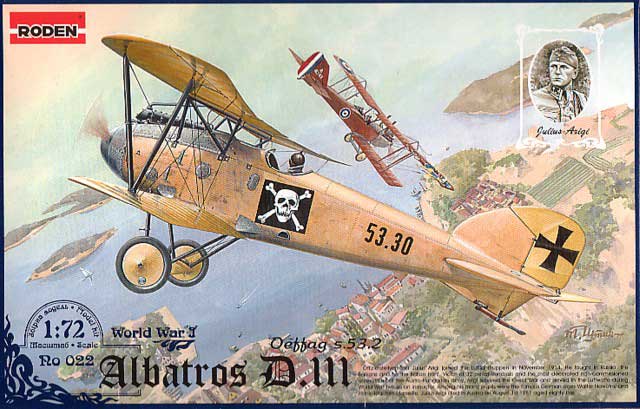
Roden

All of Roden's 1/72 scale Albatros' are
available online from Squadron.com
S
u m m a r y
|
| Catalogue Number: |
Roden 1/72 Albatros D.III Oeffag
s.53.2 Kit No. 022
Roden 1/72 Albatros D.III Oeffag s.153 (late) Kit No. 030 |
| Scale: |
1/72 |
| Contents and Media: |
Over 65 grey plastic parts; markings
for many options in each kit |
| Price: |
USD$6.96 from
Squadron.com
|
| Review Type: |
FirstLook |
| Advantages: |
Delicate parts,
well researched, plentiful decal options |
| Disadvantages: |
Difficult
fuselage assembly. Decals out of register |
| Recommendation: |
Recommended |
Reviewed by Robert Baumgartner
There is more joy for the fans of WWI aircraft as Roden
continue the release of their range of Albatros fighters.
This time it is the Austro-Hungarian aircraft fans that
benefit with the emergence of the Albatros D.III Oeffag s.53.2 and s.153
types. The two kits share common sprue and the very clear instructions
make sure you select the right item. The sprue are lettered A, C, E, F,
and W. and we shall look at each one in turn.
Each kit has a generous choice of markings with one of
them portrayed in colour on the back of the box.
The eagle-eyed buyer will note that the kit boxes have been improved with
an all gloss finish, which can only help in its “on shelf” appeal.
Sprue W
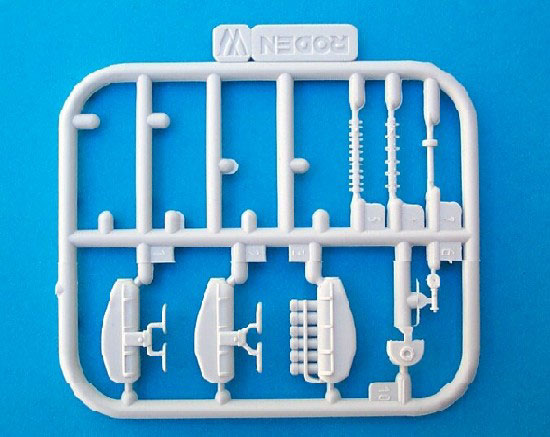
The s.53.2 used the 185hp Daimler engine whereas the s.153
used the highly compressed 200 hp Daimler engine. Both are supplied as
very clean moldings on this sprue. The instructions correctly show which
parts are applicable to each airframe.
Sprue E
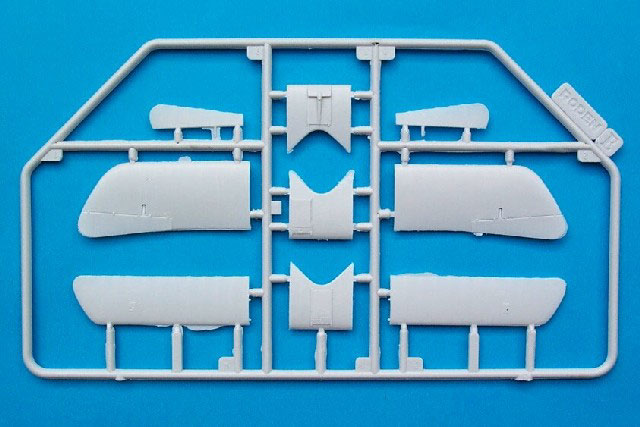
The wings on both versions are exactly the same so no
decision-making is needed here. Sprue E contains the 3-piece upper and
single piece lower left and right wings. A separate insert allows the
correct radiator to be used so as to allow maximum economy with the
tooling process. Despite appearances, the top wing parts do fit together
well with only the slightest smear of filler needed to hide the joins. The
trailing edges are very good on all wings but do require a little clean up
with “wet and dry” paper. Rib detail is subtle and the portrayal of the
aileron control lever is especially pleasing. A comparison was made to Ian
Stair’s drawings in the Albatros Publications Datafile on the D.III (Oef).
There were no anomalies found and it is clear that Roden used this as one
of the reference sources in the designing of the kits.
Sprue F
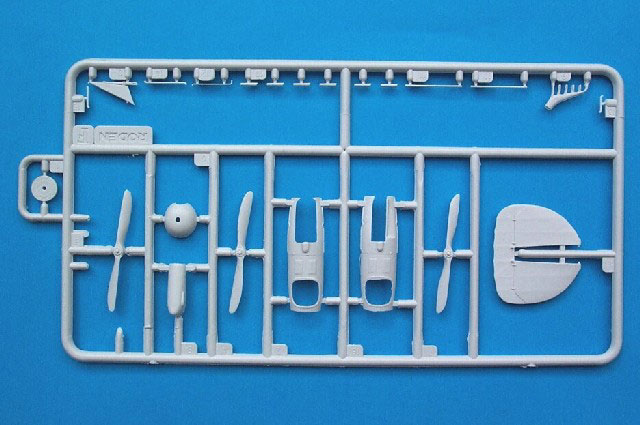
Roden have kitted a late production batch s.153 as evident
from the rounded nose, which replaced the spinner of the earlier machines.
The instructions correctly identify these parts for the s.153 and the
shapes have been captured very well. The spinner plate looks fantastic for
those that want to have the spinner removed on the s.53.2 and the types
chunky exhaust is also well captured. A slight sink mark was present near
one of the pipes but a quick dab of putty would soon solve this.
Thoughtfully, the plumbing from engine to radiator has
also been included.
This sprue also contains 3 different styles of propeller (Roden
have done their research well!) so the spare parts box is grateful.
The breakdown of parts for the frontal fuselage area will
require much dry fitting and careful alignment. Assembly of this area in
previous releases has proved to be challenging! Patience will reward but
the putty will still be required.
If installing the engine “hood”, don’t forget to drill
holes in the front to allow the machine gun barrels to poke through. As
before, a little refining of the edges of some of the parts won’t go amiss
to allow a more snug fit.
Separate tapered exhausts for the s.153 are provided but
these will prove troublesome to clean up. Another way of replicating these
is to use soft plastic tube of the correct diameter and partly inserting
an over sized pin. This will stretch the outside diameter enough to
reproduce this feature with no seam lines to clean up.
Sprue C
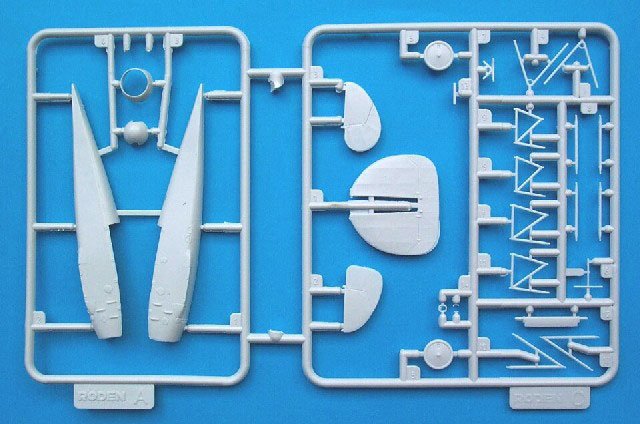
The wonderfully thin struts will need care when removing
so as not to cause breakage. It is a credit to Roden that they can mold
these so well in this thickness. The wheels appear to be a bit undersize,
but nothing too dramatic. The fin and tail plane pass the scale test and
only need a little sanding of their edges before they can be used.
Sprue A
The cockpit area comprises of some interior structural
details, rudder bar, control column, seat, and delicate handgrip. The
various dials, throttle, pressure pump, fuel switch, magneto etc. can all
be added as per the modeler’s skills and patience. The multi purpose
fuselage is well molded and the instructions tell you which details to
sand off to make this series of fighters. All the outlines compare well
very favourably with Ian Stairs plans in Datafile No 19 as well as the
details contained in the JaPo book “Albatros D.II & D.III Oeffag”.
Albatros D.III Oeffag s.53.2 Kit
No.022
1. Alb.D.III (Oef) s.53, w/n 53.27, Flik 42J, October 1917
Flown by Franz Graser. Although also flown by Godwin Brumowski and
Gottfried Banfield, it is depicted here as piloted by Franz Graser. The
indicated dark green in the instructions should be light green as relayed
in an interview by Banfield to Dr. Martin O’Connor. Dark green is also
quoted for the struts but all these should be black.
2. Alb.D.III (Oef) s.53, w/n 53.60, Flik 41J, Summer 1917 Flown by Kurt
Gruber. Also on the Isonzo front, this aircraft was stationed at Sesana
airfield. Although showing the same basic scheme as the previous machine,
the dark green fuselage area is correct. The struts though should still be
black. Top marks to Roden for spotting the markings on top of the
fuselage.
3. Alb.D.III (Oef) s.53, w/n 53.57, Flik 51J, Autumn 1917 Flown by Eugen
Bonsch. This machine gave Bonsch his first victory on 1st September 1917
with Flik 51J. Black struts are again the order of the day.
4. Alb.D.III (Oef) s.53, w/n 53.33, Flik 48D, July 1917 Flown by Viktor
Zimmermann. Josef Kiss also flew this aircraft in July 1917. As depicted,
it represents a Flik 24 machine as evident from the black nose, wheels and
struts. Both Fliks shared Pergine airfield with Flik 48 having red noses,
wheels and struts.
5. Alb.D.III (Oef) s.53, w/n 53.37, Flik 48J, October 1917 Flown by Josef
Kiss. Note that the angle of the skull marking is correct. It was applied
so as to be level when the aircraft was viewed on the ground.
6. Alb.D.III (Oef) s.53, w/n 53.30, Flik 6F, Spring 1918 Flown by Julius
Arigi.
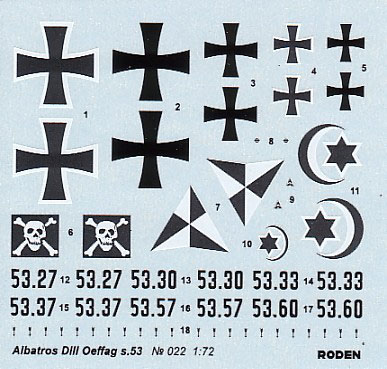
Albatros D.III Oeffag s.153.2 Kit No 030
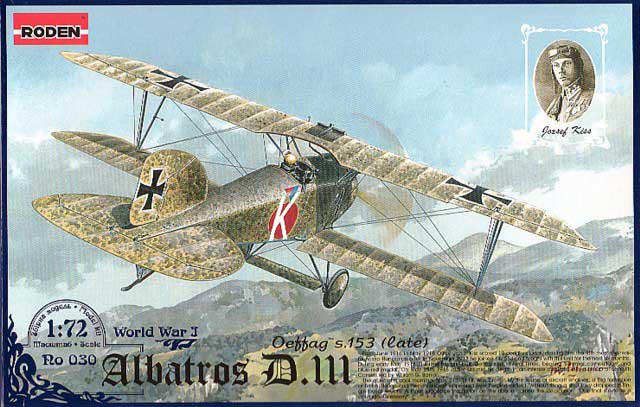
1. Alb.D.III (Oef) s.153 (late), w/n 153.151, Flik 9J, May
1918 Flown by Lajos Telessy. This is the aircraft in which Telessy
suffered fatal wounds after a dogfight on 9th June 1918.
2. Alb.D.III (Oef) s.153 (late), w/n 153.198, Flik 3J, July 1918 Flown by
Friedrich Navratil. Navratil scored his second victory (an Italian Spad)
in 153.198 on the 28 June 1918 while commanding Flik 3J.
3. Alb.D.III (Oef) s.153 (late), w/n 153.137, Flik 41J, January 1918 Flown
by Josef Novak. Before being downed on 6th may 1918, aces Brumowski, and
Navratil also flew this aircraft. “Lil” on the fuselage side was short for
Lilian.
4. Alb.D.III (Oef) s.153 (late), w/n 153.199, Flik 3J, August 1918 Flown
by Otto Forster
5. Alb.D.III (Oef) s.153 (late), w/n 153.125, Flik 42J, March 1918 Flown
by Laszlo Hary
6. Alb.D.III (Oef) s.153 (late), w/n 153.186, Flik 55J, April 1918 Flown
by Josef Kiss Enrica Bonecker, who was the sweetheart of Josef at Pergine,
confirmed the colours of the personal marking.
7. Alb.D.III (Oef) s.153 (late), w/n 153.167, Flik 2D, Spring 1918 Flown
by an unknown
8. Alb.D.III (Oef) s.153 (late), w/n 153.140, Flik 51J, March-July 1918
Flown by Eugen Bonsch. Of the five confirmed victories in this machine,
the pilot’s 7th was a balloon scored in this aircraft on 3rd April 1918.
9. Alb.D.III (Oef) s.153 (late), w/n 153.173, Flik 3J, August 1918 Flown
by Stanislav Maria Tomicki von Tomice. He was killed in this aircraft on
31st of August 1918 after combat with British fighters.
10. Alb.D.III (Oef) s.153 (late), w/n 153.246, Flik 3J, July 1918 Flown by
Otto Forster
11. Alb.D.III (Oef) s.153 (late), w/n 153.119, Flik 61J, February-March
1918
Flown by Ernst Strohschneider. His 14th and 15th confirmed victories were
made in 153.119. The former an Italian Macchi M.5 and the later an Italian
Ansaldo SVA.
12. Alb.D.III (Oef) s.153 (late), w/n 153.209, Flik 41J,
June 1918 Flown by Godwin Brumowski. The top ranking Austro-Hungarian ace
with 35 confirmed victories. 153.209 was used for the last four of these.
This aircraft has been photographed with a captured British Aldis
telescopic sight. There was also a mount attached to the top wing that
could have been for the purpose of a flare gun.
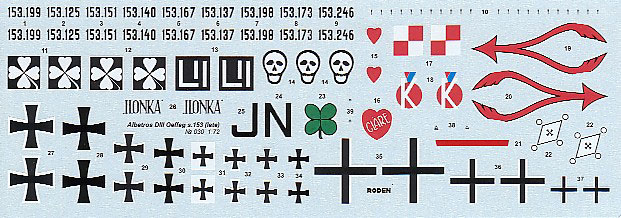
Roden once again excel themselves with the choice and
sheer number of decal options. The decals are commendably thin but I
personally don’t like the matt finish. Unfortunately, my examples were out
of register, so the range of colour schemes suddenly narrows. In my case,
it also means searching for alternative crosses.
This is another fine effort from Roden with a well
researched and produced product.
The delicate nature of some of the parts means that a kit
in this scale doesn’t have to look “chunky”. Inevitably, there will be
some fit problems with a kit that has been engineered for this number of
variants. With careful dry fitting when assembling the nose, the heart
rate can be kept to a minimum. The only major fault was with the decals so
some quality control in this area is needed.
Thanks to Roden, we now have these variants as valuable
additions to the ever-increasing family of Albatros fighters.
Increase your Austro-Hungarian aircraft collection now!
Recommended
Thanks to
Squadron.com for the review
sample.
Review and Images Copyright © 2002 by
Robert Baumgartner
Page Created 03 September, 2002
Last updated 22 July, 2003
Back to HyperScale Main Page
Back to Reviews Page
|
Home | What's
New | Features
| Gallery |
Reviews | Reference
| Forum
| Search